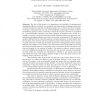506 search results - page 87 / 102 » Distributing synchronous programs using bounded queues |
103
Voted
AAMAS
2008
Springer
14 years 11 months ago
2008
Springer
As the scale and scope of distributed and multi-agent systems grow, it becomes increasingly important to design and manage the participants' interactions. The potential for b...
93
Voted
PODC
2000
ACM
15 years 4 months ago
2000
ACM
Stampede is a parallel programming system to facilitate the programming of interactive multimedia applications on clusters of SMPs. In a Stampede application, a variable number of...
CASES
2009
ACM
15 years 6 months ago
2009
ACM
Embedded processors have become increasingly complex, resulting in variable execution behavior and reduced timing predictability. On such processors, safe timing specifications e...
TCC
2009
Springer
16 years 6 days ago
2009
Springer
: The aim of this paper is to demonstrate the feasibility of authenticated throughput-ecient routing in an unreliable and dynamically changing synchronous network in which the majo...
120
Voted
WSC
2007
15 years 2 months ago
2007
Adaptive Time Warp protocols in the literature are usually based on a pre-defined analytic model of the system, expressed as a closed form function that maps system state to cont...


